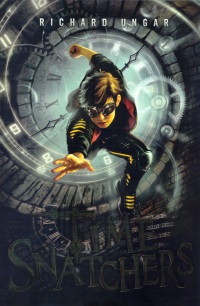| ________________
CM . . .
. Volume XVIII Number 41. . . .June 22, 2012
excerpt:
Thirteen-year-old Caleb is part of an elite team of time snatchers, teenagers who venture back in time to steal artifacts of historical and cultural significance on the behalf of wealthy clientele. Caleb has thoroughly enjoyed his time so far, having been raised in the business since the age of three after being adopted by the entrepreneurial genius Uncle; however, all is not entirely well. Caleb, growing tired of the relentless bullying of rival ‘snatcher’ Frank, and the increasing sternness exhibited by the once benevolent Uncle, is seriously contemplating running away. But where can Caleb go to escape, and how will he be able to survive alone? He could seek refuge into the past, but even that may not be far enough to avoid the reach and retribution of Uncle who will not look favourably on Caleb’s defection should he ever make the decision to flee. The opening chapters of Time Snatchers work marvelously to build the above described scenario; it is also in this space that readers are introduced to the supporting cast of characters of whom the most important (at least as it concerns Caleb) is Abbie. She comes across as being strong, confident, and witty in her observations and interactions with others, qualities which, in addition to her natural beauty, make her the perfect complement to Caleb and the reason why he is so drawn to her beyond a mere friendship. Other characters are described only minimally, revealing little about themselves in relation to their individual thoughts, feelings, and motivations. The consequence of this to the overall story is not, by any means, catastrophic, especially considering that Time Snatchers is by and large an action based book driven forward by fast plot sequences and chapter ending cliffhangers. Richard Ungar’s rendering of Caleb, in contrast, is handled with great care. He is sophisticated and mature beyond his years, as well as remarkably sensitive and compassionate, especially in matters which concern right and wrong. He is firm in his convictions and is willing to sacrifice everything, even his own personal safety and happiness, in order to keep these tenets intact. As such, when Caleb learns that Zach, an adolescent boy he befriends on one of his missions back in time, is placed in danger by Uncle’s new plans for the business, he is quick to act to make things right. With Time Snatchers set in New York City in the year 2061, an attempt is made to introduce readers to an alternative world which is based loosely on the economic and political trappings of contemporary society. Whether these nuances will be recognized or altogether understood by younger readers is unlikely. Nevertheless, the world that is created is rich and sets up several exciting scenarios for Caleb and the other characters. Much in the same way, setting the story half a century into the future makes the premise of time travel and the other technological advances featured in the story much more believable. In any event, readers will tend to gravitate more closely to the settings visited in the time travel sequences. Ungar does an appropriate job in selecting diverse landscapes and times, and while some of the destinations are mundane, the items that are set up to be stolen (the first photograph, the original Frisbee, Winston Churchill’s umbrella, etc.) and the history of these artifacts which the author explores (and embellishes) make for an interesting and enlightening story. Ungar’s debut novel is a wonderfully imagined and executed science fiction tale. The book will have mass appeal among young middle grade readers, but it will likely resonate most strongly with young adult males given the prominence of Caleb’s story. It should be noted that Time Snatchers is not all fun and games; the tone is rather heavy and dark, if not altogether sinister at times as Caleb is forced to confront and cope with issues of abandonment, loss, and identity from both his past and present. Highly Recommended. Andrew Laudicina, a recent MLIS graduate from the University of Western Ontario in London, ON, currently resides in Windsor, ON.
To comment
on this title or this review, send mail to cm@umanitoba.ca.
Copyright © the Manitoba Library Association. Reproduction for personal
use is permitted only if this copyright notice is maintained. Any
other reproduction is prohibited without permission.
NEXT REVIEW |
TABLE OF CONTENTS FOR THIS ISSUE
- June 22, 2012.
AUTHORS |
TITLES |
MEDIA REVIEWS |
PROFILES |
BACK ISSUES |
SEARCH |
CMARCHIVE |
HOME |
